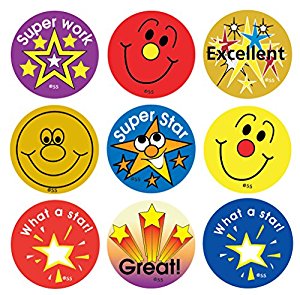 Several years ago, I had a sub who went a bit above and beyond. She not only took up whatever assignment I’d left for that day – she organized the papers and completion-graded them. In other words, she noted who’d finished and seemed to have taken the work seriously. She didn’t give them a number or a letter grade, of course – that would have been bold. But she did give each paper meeting her requirements a sticker.
Several years ago, I had a sub who went a bit above and beyond. She not only took up whatever assignment I’d left for that day – she organized the papers and completion-graded them. In other words, she noted who’d finished and seemed to have taken the work seriously. She didn’t give them a number or a letter grade, of course – that would have been bold. But she did give each paper meeting her requirements a sticker.
I chuckled when I saw the papers the next day. Clearly this was someone more comfortable with elementary, maybe middle school. Nothing wrong with any of that, of course, but these were high school students. Pre-AP Freshmen. They were practically people. They weren’t going to be motivated by…
Holy Moses in a leaky basket, how they lost their minds when they saw the stickers. There was squealing from many of the girls, and almost genuine protest from some of the boys whose papers lacked the adhesive trolls or monkeys or whatever they were. I couldn’t believe it.
“Mr. Cereal! How come you never give us stickers? Don’t you love us? Do you not care if we do well?!?”
OK, they were partly kidding, but not entirely. Not even mostly. Many of them responded more powerfully than I could have ever imagined to the freakin’ stickers. Still… surely it was a fluke, right? A one-time thing? Kids are weird – you never know what’s gonna trigger them one day and mean nothing the next. I dismissed it as quickly as I had pet rocks and disco back in the day.
 A week or two later I was at one of those Everything’s A Dollar So Stop Asking places with my wife, looking for who-knows-what, and I noticed several packages of the most obnoxious rainbow and puppy stickers. I grabbed them. Then some generic superheroes – not Marvel, not even DC, but some cheap knock-off assortment of colorful caped stereotypes. I spent less than ten dollars total, purely on a whim – what they heck, right?
A week or two later I was at one of those Everything’s A Dollar So Stop Asking places with my wife, looking for who-knows-what, and I noticed several packages of the most obnoxious rainbow and puppy stickers. I grabbed them. Then some generic superheroes – not Marvel, not even DC, but some cheap knock-off assortment of colorful caped stereotypes. I spent less than ten dollars total, purely on a whim – what they heck, right?
The next reading quiz, students who scored a natural 100% (getting all the multiple choice questions right, not factoring in bonus points available from the more-involved short answer questions) received a sticker on their quiz next to the grade.
They loved it. It was almost embarrassing how quickly it escalated.
Students previously satisfied with 88% actually put in extra time to get stickers on their quizzes. A few kids who weren’t going to be getting 100% on their best day received them periodically for the largest jump in scores between quizzes or other nonsense. In short, it became a thing. I did it for years just because I found it amusing. Sometimes it seemed to actually change behavior, but over time it was mostly just stupid fun. The stickers weren’t driving the curriculum or anything – I wasn’t gamifying my flipped project-based #edtech lesson. They were a fluke that found traction.
 I may have gotten a bit too excited and purchased way too many random, quirky packs of adhesive approval throughout the years. There were a few times I almost gave assignments just to use my cool new stickers! (Almost, I said. Stop judging me!)
I may have gotten a bit too excited and purchased way too many random, quirky packs of adhesive approval throughout the years. There were a few times I almost gave assignments just to use my cool new stickers! (Almost, I said. Stop judging me!)
Why am I telling you this?
We can professionally develop ourselves silly and memorize every Marzano text available-at-this-sponsored-link-please-buy-everything-I-get-a-percentage, and still sometimes it’s gonna be the weirdest, most random things that work – or at least work with some kids, in some situations, for some teachers, some of the time. When I’ve shared this with other educators, no one is surprised. Kids are weird like that, but of course teachers aren’t the most normal people in the world, either.
I suspect it was a type of unexpected approval, or a relationship-builder, maybe. I don’t really know for sure. And honestly, I didn’t entirely care – it was just something that worked for me, so I share it. Other teachers share what they do, also, and together we figure out what works most of the time. Some of us also lead workshops sharing ideas and strategies, much based on research and sound pedagogy, and some just based on experience and time. We can explain why some of it works, while some things just… do.
And then one day it didn’t.
I was bouncing through an introductory discussion with a new group of kids and someone shared a particularly pithy comment (I have no recollection what). I reacted with great approval and announced that THAT deserves a STICKER! as I marched back to my desk where I’d tucked them away for just such a joyous…
Nothing.
There was nothing.
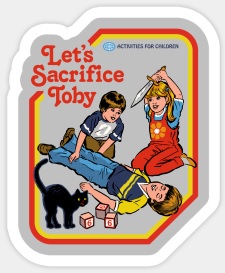 I mean, I gave her the sticker. She said thanks, and looked a little confused. We kept going, and eventually I reacted to another thoughtful response with a second sticker. Then a third. Because when something’s not working, you have to do it more, faster, and with greater emphasis.
I mean, I gave her the sticker. She said thanks, and looked a little confused. We kept going, and eventually I reacted to another thoughtful response with a second sticker. Then a third. Because when something’s not working, you have to do it more, faster, and with greater emphasis.
Still… nothing.
They were polite enough. The discussion went fine. The stickers just made no sense to them. Maybe it was my timing, or the context, or just a different group in a different state coming from different backgrounds. No biggie – we’ve found other ways to connect and learn and for me to push them to give a little more. I don’t need to understand what changed, precisely – although in hindsight I do wonder if I went a bit Bill Murray throwing snowballs in Groundhog Day and killed it. If I’m being honest, it had stopped working in conferences a couple of years earlier, but I’d kept doing it out of sheer momentum (and teachers tend to be overly polite about such things).
So, mild embarrassment I hadn’t caught on a bit more quickly, but no real harm and no lasting foul.
It never occurred to me to write a book about it, do a video series, start upping my lecture fee, or smother social media in derisive comments about teachers who don’t use stickers. I suppose I could have at least hit up Pearson or TEDx, but like I said, I’m just… slow that way. Plus, while the most casual perusal of my Twitter feed will easily dismiss any suspicions I might be carefully building a brand over here, I do have some shame. I may not get edu-famous (and yeah, I want to – who doesn’t?), it’s more important I be able to sleep at night.
Still, I could have shared it more vocally, I guess. There’s nothing more rewarding when you’re a relatively new teacher than stumbling across something that works – a lesson, a classroom management technique, even a book of stickers. And you should rejoice in those moments; they’re largely why we signed up. And I’m always happy to share. I have entire sections on each of my websites hoping there are folks who find them useful from time to time.
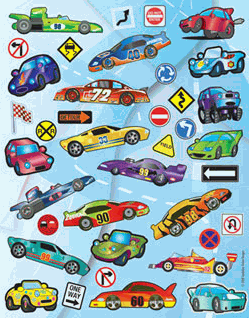 And one day they won’t work, or at least they won’t work the same way. That doesn’t mean I’ve failed, or that you’re doing it wrong. It just means that things change. The kids are different. You’re different. The context is ever-evolving and the exact dynamics maddeningly elusive. So we’ll find something else. You’ll try it another way. I’ll screw up a few times, feel like an idiot, then stumble into pedagogical brilliance once again.
And one day they won’t work, or at least they won’t work the same way. That doesn’t mean I’ve failed, or that you’re doing it wrong. It just means that things change. The kids are different. You’re different. The context is ever-evolving and the exact dynamics maddeningly elusive. So we’ll find something else. You’ll try it another way. I’ll screw up a few times, feel like an idiot, then stumble into pedagogical brilliance once again.
Keep sharing those ideas. Keep going to those trainings – if you wish, I mean. Take in all useful ideas and figure out how to make them your own.
But don’t be afraid to follow your gut and do the illogical or unexpected thing, as long as it’s not unfair or in some way detrimental to your overall goals. And don’t be too proud to borrow from that irritating lady down the hall, or that coach who you won’t admit you feel smugly superior to in the classroom, or even from that weird sub who organized all of the papers and wrote completion grades on them.
It’s a tough enough gig even when it all works – no need to invent it all yourself or go it completely alone. Try stuff. Who knows what might happen?
And if you take a few risks and they turn out particularly well, I’ll even give you a sticker.
I have plenty left, believe me.
RELATED POST: Why Kids Learn (a.k.a ‘The Seven Reasons Every Teacher Must Know WHY Kids Learn!’)
RELATED POST: My Teaching Philosophy
RELATED POST: Hetalia: Axis Powers (Toast With A Big Boot!)


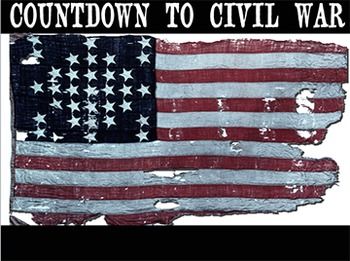
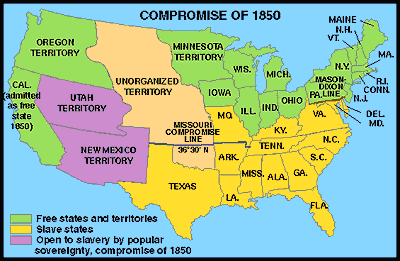 On January 29, 1850, Henry Clay proposed the Compromise of 1850 to Congress. It was a collection of five bills he said would help prevent further conflict between the North and the South. Texas gave up its claims to New Mexico and other areas north of the Missouri Compromise line and the U.S. took over their remaining debts. California was admitted to the Union as a free state. Utah and New Mexico would enter the U.S. under the principal of ‘popular sovereignty’ – meaning the people in each would vote for whether or not to have slavery. The slave trade, but not slavery itself, was banned in the District of Columbia. A much tougher Fugitive Slave Act was enacted.
On January 29, 1850, Henry Clay proposed the Compromise of 1850 to Congress. It was a collection of five bills he said would help prevent further conflict between the North and the South. Texas gave up its claims to New Mexico and other areas north of the Missouri Compromise line and the U.S. took over their remaining debts. California was admitted to the Union as a free state. Utah and New Mexico would enter the U.S. under the principal of ‘popular sovereignty’ – meaning the people in each would vote for whether or not to have slavery. The slave trade, but not slavery itself, was banned in the District of Columbia. A much tougher Fugitive Slave Act was enacted. 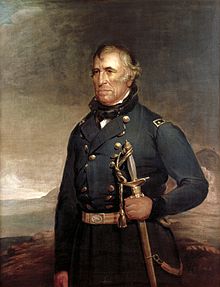 President Zachary Taylor died unexpectedly in July of 1850 of what seemed to be a stomach-related illness. Some suggested he may have been assassinated by pro-slavery southerners, and various theories have persisted into modern times. In 1991, Taylor’s body was exhumed and tests were done in an effort to determine whether or not he had, in fact, been poisoned. The science found no evidence of malicious behavior, but some question the results even today.
President Zachary Taylor died unexpectedly in July of 1850 of what seemed to be a stomach-related illness. Some suggested he may have been assassinated by pro-slavery southerners, and various theories have persisted into modern times. In 1991, Taylor’s body was exhumed and tests were done in an effort to determine whether or not he had, in fact, been poisoned. The science found no evidence of malicious behavior, but some question the results even today. 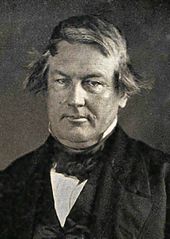 On July 10, 1850, Millard Fillmore was sworn into office as the 13th President of the United States. Neither expansionists nor slave-holders were generally happy with his publicly stated policies regarding slavery, although it would be wrong of me to try to speak for them or evaluate their reasoning.
On July 10, 1850, Millard Fillmore was sworn into office as the 13th President of the United States. Neither expansionists nor slave-holders were generally happy with his publicly stated policies regarding slavery, although it would be wrong of me to try to speak for them or evaluate their reasoning.  On September 11, P.T. Barnum introduced Jenny Lind to American audiences. Often called the “Swedish Nightingale,” Lind was a soprano who performed in Sweden and across Europe before her wildly popular concert tour of America. She donated many of her earnings to charities, especially the endowment of free schools in Sweden. Some people think that sort of philanthropy is noble; others find it less so. Best we not consider such issues here. Or the role of the arts in influencing culture or character.
On September 11, P.T. Barnum introduced Jenny Lind to American audiences. Often called the “Swedish Nightingale,” Lind was a soprano who performed in Sweden and across Europe before her wildly popular concert tour of America. She donated many of her earnings to charities, especially the endowment of free schools in Sweden. Some people think that sort of philanthropy is noble; others find it less so. Best we not consider such issues here. Or the role of the arts in influencing culture or character.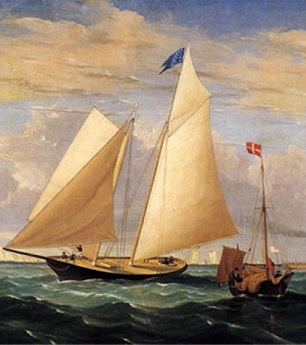 On August 22, 1851, a yacht named “America” won the first America’s Cup yach race, as things named “America” always should. This may have had an impact on different segments of the nation, or it may not have.
On August 22, 1851, a yacht named “America” won the first America’s Cup yach race, as things named “America” always should. This may have had an impact on different segments of the nation, or it may not have. December 1851 – The first Y.M.C.A. opens in Boston, Massachusetts. This arguably reflected changing values and social strategies in northern cities – if we were going to talk about values, I mean. Which we won’t. Because… school. So, um… the Village People recorded “Y.M.C.A.” in 1978 and it became a huge disco hit. If you’ve ever been to a live sporting event, you’ve heard this song and watched people do weird things with their arms which they seem to think are related to the song.
December 1851 – The first Y.M.C.A. opens in Boston, Massachusetts. This arguably reflected changing values and social strategies in northern cities – if we were going to talk about values, I mean. Which we won’t. Because… school. So, um… the Village People recorded “Y.M.C.A.” in 1978 and it became a huge disco hit. If you’ve ever been to a live sporting event, you’ve heard this song and watched people do weird things with their arms which they seem to think are related to the song. 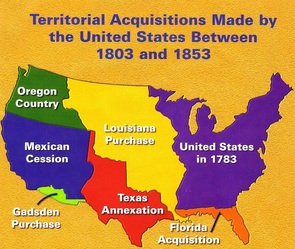 1853 – America and Mexico signed the Gadsden Treaty. Vice President William King died. Arctic explorer Elisha Kane ventures farther north than any man has before.
1853 – America and Mexico signed the Gadsden Treaty. Vice President William King died. Arctic explorer Elisha Kane ventures farther north than any man has before.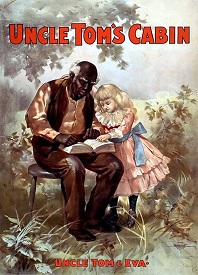
 There’s nothing more terrifying than finding out your district administrators have just returned from a conference somewhere, and they’re excited about something. You know because they suddenly smile too much, and now they want to come talk to your department or hold a special faculty meeting. It’s enough to ruin your entire 17-minute lunch period.
There’s nothing more terrifying than finding out your district administrators have just returned from a conference somewhere, and they’re excited about something. You know because they suddenly smile too much, and now they want to come talk to your department or hold a special faculty meeting. It’s enough to ruin your entire 17-minute lunch period.
 You know where it’s going from there. It’s time to do more PBL (Project Based Learning). More STEALHAM (Science Technology Engineering Arts Literacy History Athletics Math). More opinions and less reality – because if we teach the way we were taught in the past we’ll create the future we dreaded in our former present! We’re preparing kids for jobs that don’t exist yet, so we need to light more fires and fill fewer buckets if we’re going to fail forward…
You know where it’s going from there. It’s time to do more PBL (Project Based Learning). More STEALHAM (Science Technology Engineering Arts Literacy History Athletics Math). More opinions and less reality – because if we teach the way we were taught in the past we’ll create the future we dreaded in our former present! We’re preparing kids for jobs that don’t exist yet, so we need to light more fires and fill fewer buckets if we’re going to fail forward… On the other hand, it’s a shame to think any civilized young person would be set loose on the world without a pretty good idea of what the Civil War was, roughly when it occurred, and some of the major changes it brought about. It’s unforgiveable if we don’t at least try to ensure that same youth understands the three branches of government and has a general grasp of how each is supposed to work.
On the other hand, it’s a shame to think any civilized young person would be set loose on the world without a pretty good idea of what the Civil War was, roughly when it occurred, and some of the major changes it brought about. It’s unforgiveable if we don’t at least try to ensure that same youth understands the three branches of government and has a general grasp of how each is supposed to work. And it’s even more essential that we emphasize data and details when addressing contemporary issues. I’m a believer in everyone being entitled to their own opinion, but I’d rather not cement my students’ ignorance by encouraging them to wax emphatic on topics about which they know little.
And it’s even more essential that we emphasize data and details when addressing contemporary issues. I’m a believer in everyone being entitled to their own opinion, but I’d rather not cement my students’ ignorance by encouraging them to wax emphatic on topics about which they know little.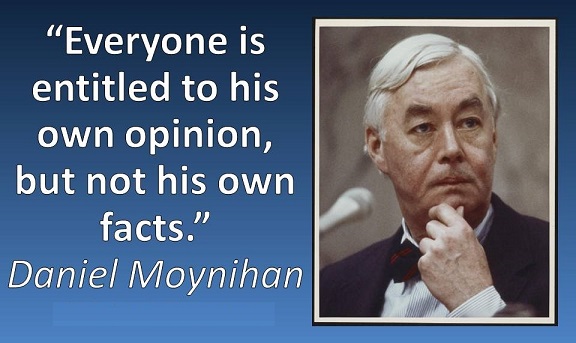 But if you’re in an academic setting, on academic time, pursuing academic goals, we should INSIST on statistics, data, experts, and records. We should at least TRY to be precise about names, dates, and other onerous “facts” before spewing our precious individuality about pretty much anything.
But if you’re in an academic setting, on academic time, pursuing academic goals, we should INSIST on statistics, data, experts, and records. We should at least TRY to be precise about names, dates, and other onerous “facts” before spewing our precious individuality about pretty much anything. I’m a bad person.
I’m a bad person. Don’t get me wrong – it’s just peachy keen swell that throwing a few computers in the middle of an impoverished village and making sure no teachers interfere practically guarantees a bunch of eight-year olds will master calculus, cure cancer, and reverse climate change. Here’s to the success of every one of those dusty darlings and even newer, bigger opportunities for them to challenge themselves AND the dominant paradigm. Seriously.
Don’t get me wrong – it’s just peachy keen swell that throwing a few computers in the middle of an impoverished village and making sure no teachers interfere practically guarantees a bunch of eight-year olds will master calculus, cure cancer, and reverse climate change. Here’s to the success of every one of those dusty darlings and even newer, bigger opportunities for them to challenge themselves AND the dominant paradigm. Seriously. Maybe it would be better to do the entire building… eleven hundred freshmen set free to learn with a bank of Dells and no silly adults with their stifling expectations. Imagine the money saved on staff – and computers never take personal days or violate professional dress code!
Maybe it would be better to do the entire building… eleven hundred freshmen set free to learn with a bank of Dells and no silly adults with their stifling expectations. Imagine the money saved on staff – and computers never take personal days or violate professional dress code! I’m not unsympathetic. I get what these writers and speakers are going for. Most are trying to make the very valid point that when we try to cram kids’ heads full of 87-pages of curriculum standards compiled by committees and approved by states to be tested by bubbles, we are unlikely to either fill their buckets OR light their fires.
I’m not unsympathetic. I get what these writers and speakers are going for. Most are trying to make the very valid point that when we try to cram kids’ heads full of 87-pages of curriculum standards compiled by committees and approved by states to be tested by bubbles, we are unlikely to either fill their buckets OR light their fires. It’s not. Remember that Oregon Trail game we were all so excited about a few decades ago? That’s still about as cutting edge as educational games have managed, and that’s not even what most virtual learning is attempting.
It’s not. Remember that Oregon Trail game we were all so excited about a few decades ago? That’s still about as cutting edge as educational games have managed, and that’s not even what most virtual learning is attempting.  There are glaring problems with this system, some within the school’s control and many more without. The biggest problem with the current model is also the most substantial barrier to all this self-directed learning we keep hearing will save us all – state legislatures dictate most of what’s supposed to be “important” and decide how these things will be assessed.
There are glaring problems with this system, some within the school’s control and many more without. The biggest problem with the current model is also the most substantial barrier to all this self-directed learning we keep hearing will save us all – state legislatures dictate most of what’s supposed to be “important” and decide how these things will be assessed. I’m a fairly narcissistic fellow. I don’t mean to be, it’s just that I’m vain and self-absorbed. At least I have the skills, style, and cojones to make it work for me. I make no apologies; every rose has it’s – oh, are you still here? I hadn’t noticed.
I’m a fairly narcissistic fellow. I don’t mean to be, it’s just that I’m vain and self-absorbed. At least I have the skills, style, and cojones to make it work for me. I make no apologies; every rose has it’s – oh, are you still here? I hadn’t noticed. I’m pretty entertaining, and I have a degree. That should buy me some leeway, yes?
I’m pretty entertaining, and I have a degree. That should buy me some leeway, yes?
 Which, by the way, is pretty much what many of you keep telling the rest of us about OUR teaching methods – that if we were doing it right, we wouldn’t have to work so hard to coerce and browbeat our darlings into cooperation. Like you’re trying to do to us.
Which, by the way, is pretty much what many of you keep telling the rest of us about OUR teaching methods – that if we were doing it right, we wouldn’t have to work so hard to coerce and browbeat our darlings into cooperation. Like you’re trying to do to us. When I’m in my classroom, my number one ethical and professional obligation has absolutely nothing to do with your studies, your strategies, and sure as hell not your tests – mandated or not. I’ll certainly consider the input of my department and my building leadership, but even those should take a back seat to what I think and feel and believe will be best for MY kids, today, right now.
When I’m in my classroom, my number one ethical and professional obligation has absolutely nothing to do with your studies, your strategies, and sure as hell not your tests – mandated or not. I’ll certainly consider the input of my department and my building leadership, but even those should take a back seat to what I think and feel and believe will be best for MY kids, today, right now. We’ve become SO comfortable doing things we know are bad for our kids because they’re ‘required’. Maybe we’re afraid, or maybe we simply hide behind what everyone else is doing. Is this such a rewarding career in terms of money, power, and glory, that we’ll sacrificing the very things that made it matter to begin with in order to keep it secure? Must be a helluva extra duty stipend.
We’ve become SO comfortable doing things we know are bad for our kids because they’re ‘required’. Maybe we’re afraid, or maybe we simply hide behind what everyone else is doing. Is this such a rewarding career in terms of money, power, and glory, that we’ll sacrificing the very things that made it matter to begin with in order to keep it secure? Must be a helluva extra duty stipend.